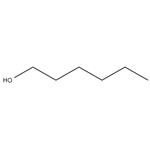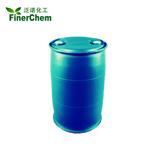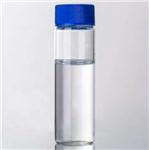- 1-Hexanol
-

- $5.00 / 1KG
-
2024-04-16
- CAS:111-27-3
- Min. Order: 1KG
- Purity: 99%
- Supply Ability: g-kg-tons, free sample is available
- Hexyl alcohol
-

- $0.00 / 1KG
-
2024-04-16
- CAS:111-27-3
- Min. Order: 1KG
- Purity: 99%
- Supply Ability: 1000mt/year
- 1-Hexanol
-

- $6.80 / 10kilograms
-
2024-04-16
- CAS:111-27-3
- Min. Order: 10kilograms
- Purity: 99%
- Supply Ability: 100tons
|
| | 1-Hexanol Chemical Properties |
| Melting point | -52 °C (lit.) | | Boiling point | 156-157 °C (lit.) | | density | 0.814 g/mL at 25 °C (lit.) | | vapor density | 4.5 (vs air) | | vapor pressure | 1 mm Hg ( 25.6 °C) | | refractive index | n20/D 1.418(lit.) | | FEMA | 2567 | HEXYL ALCOHOL | | Fp | 140 °F | | storage temp. | no restrictions. | | solubility | ethanol: soluble(lit.) | | pka | 15.38±0.10(Predicted) | | form | Liquid | | color | Clear colorless | | Relative polarity | 0.559 | | Odor | Sweet; mild. | | Odor Threshold | 0.006ppm | | explosive limit | 1.2-7.7%(V) | | Odor Type | herbal | | Water Solubility | 6 g/L (25 ºC) | | JECFA Number | 91 | | Merck | 14,4697 | | BRN | 969167 | | Dielectric constant | 13.3(24℃) | | Stability: | Stable. Substances to be avoided include strong acids, strong oxidizing agents. Combustible. | | LogP | 1.8 | | CAS DataBase Reference | 111-27-3(CAS DataBase Reference) | | NIST Chemistry Reference | 1-Hexanol(111-27-3) | | EPA Substance Registry System | 1-Hexanol (111-27-3) |
| Hazard Codes | Xn | | Risk Statements | 22 | | Safety Statements | 24/25 | | RIDADR | UN 2282 3/PG 3 | | WGK Germany | 1 | | RTECS | MQ4025000 | | Autoignition Temperature | 559 °F | | TSCA | Yes | | HazardClass | 3 | | PackingGroup | III | | HS Code | 29051900 | | Hazardous Substances Data | 111-27-3(Hazardous Substances Data) | | Toxicity | LD50 oral in rat: 720mg/kg |
| | 1-Hexanol Usage And Synthesis |
| General Description | Colorless liquid. The boiling point is 157 ° C; the relative density is 0.819. Miscible in ethanol, propylene glycol and oil. There are light blue shoots breath, wine, fruit and fat flavor.
Naturally occurs in some fruits such as apples, strawberries, bitter oranges, also found in camphor oil, tea leaves, tobacco leaves, eucalyptus and coffee. It appears as colorless transparent liquid with fruit-like aroma at low concentration. Sweet; rapidly oxidized in the air; can have polymerization reaction upon contact with concentrated inorganic acid. Similar to normal fatty aldehydes, it can be oxidized to caproic acid and reduced to hexanol.
| | Uses |
- It often acts as part of the head incense used in fragrance base and formulated essential oil (such as geraniol oil). A trace of hexanol is used for violet, sweet-scented osmanthus, magnolia, ylang-type flavor to modify or increase the tender atmosphere, as well as used for edible coconut formula, berries and various types of fruit flavor. It is used as solvents and analytical reagents, also used in the pharmaceutical industry for preservatives and sleeping pills. The goods are listed in China's GB 2760-96. It is mainly used to prepare coconut and berry flavor and used for the production of surfactants, plasticizers, fatty alcohols and so on. It is also used for chromatography reagents and organic synthesis.
- Gas chromatography analysis standards. Lithium chloride was isolated from potassium chloride and sodium chloride. Solvent.
- In the synthesis of spices and the preparation of caproic acid; also used as gas chromatography reagents for Wittig and Aldol reactions.
| | Content Analysis | Add 700 ml of newly distilled pyridine into a 1000 ml brown bottle with a glass stopper; add phthalic anhydride 11 5g with strong shaking to complete dissolution. Take the solution 25.0ml, adding into a bottle with heat pressure resistance. The bottle are tightly wrapped and fixed.Weigh the sample about 1 g with the weighing pipette; add it into the pressure bottle; stamped. The sample was fixed in a canvas bag, heated in a water bath at 98~100 ℃ for 3h, and let the water level in the water bath higher than the bottle level. After removal, cool it to room temperature; carefully open the stopper, and do not make a content loss. Add 0.5mol/L sodium hydroxide solution 50.0ml (Note: This 50.0ml 0.5mol/L sodium hydroxide solution is not included in the final calculation). Add 1% phenolphthalein 5 drops of pyridine solution, and then 0.5 mol/L sodium hydroxide solution to the pink end point and maintain 15 s unchanged. At the same time carry out a blank test. Per milliliter of sodium hydroxide solution 0.5mol/L is equivalent to alcohol (C6H14O) 51.09 mg. Or measured by non-polar column in GT-10-4 gas chromatography. | | maximum level | FEMA (mg/kg): soft drinks 6.6; cold drinks 26; candy 21; baked food 18; puddings 0.22 to 0.28.
Moderation (FDA § 172.515, 2000). | | Preparation |
- Hexanol oxidation;
- Use calcium hexanoate and formic acid as the raw materials, heat and reflux them to obtain it.
| | Production methods | (1) It is generally derived from acetic acid reduction in industry. Bromine butane and magnesium shards reaction obtains butyl magnesium bromide, and the butyl magnesium bromide reacted with ethylene oxide to get ethanol under laboratorial study.
(2) Via n-hexylic acid reduction. | | Hazards & Safety Information | Category: Flammable liquids
Toxic classification: Moderately hazardous
Acute toxicity
Oral-Rat LD50: 720 mg/kg; Oral-mouse LD50: 1950 mg/kg
Stimulation data: Skin-Rabbit 10 mg/24 h Mild; Eye-Rabbit 250 μg Severity.
Flammability characteristics: In case of fire, high temperature, strong oxidant flammable; combustion emissions to stimulate smoke
Storage and transport: Packaging integrity, light loading and unloading; Treasury ventilation, away from open flame, high temperature, stored separately from the oxidant.
Fire extinguishing agent: Foam, dry powder, carbon dioxide, sand. | | Description | Hexyl alcohol has a fruity odor and aromatic flavor. May be
synthesized by reduction of n-caproic acid; the n-hexyl alcohol
represents one of the 14 possible isomers of this alcohol. | | Chemical Properties | Hexyl alcohol has an herbaceous, woody, fragrant, mild, sweet, green fruity odor and aromatic flavor. | | Chemical Properties | Colourless liquid (odour recognition threshold 0.09ppm) | | Chemical Properties | 1-Hexanol is a liquid at room temperature.The absolute perceived concentration has been reported as
0.01 ppm, and the recognition level is 0.09 ppm . | | Occurrence | Reported found among the constituents of several essential oils and aromas: apple, strawberry, tea, violet
(leaves and flowers), Java citronella, Bourbon geranium, lavender, lavandin, spike, Litsea zeylanica; also identified in bitter orange.
Also reported found in over 300 natural sources including apples, banana, sweet and sour cherry, citrus peel oils and juice, kumquat
peel oil, berries, guava, grapes, raisin, melon, papaya, peach, pear, pineapple, asparagus, kohlrabi, cabbage, celery, cucumber, lettuce,
leek, garlic, raw and cooked potato, sauerkraut, tomato, bell pepper, ginger, mint oils, mustard, breads, cheeses, butter, milk, fatty
fish, meats, cognac, whiskies, rum, cider, grape wines, coffee, tea, cocoa, peanut oil, pecans, soybeans, nuts, coconut meat and milk,
avocado, olive, passion fruit, plum, beans, mushrooms, starfruit, mango, fenugreek, sesame seed oil, figs, kelp, cardamom, coriander,
gin, rice, fruit brandies, prickly pear, licorice, lovage corn oil, endive, truffles and other sources | | Uses | 1-Hexanol has been used as an odorant to study olfactory responses and to thin the dielectric layer of poly(4-vinylphenol) (PVP). | | Uses | 1-Hexanol is used as a precursor to plasticizers, chemical intermediate for pharmaceuticals, perfume esters and antiseptics. Further, it serves as a perturbing agent on actomyosin adenosine triphosphatease. In addition to this, it is used to modulate the function of actomyosin motor. | | Uses | 1-Hexanol was examined as a perturbing agent on actomyosin ATPase and and was found to modulate the function of actomyosin motor via intermediate-specific structural perturbation. | | Definition | ChEBI: A primary alcohol that is hexane substituted by a hydroxy group at position 1. | | Production Methods | 1-Hexanol is commercially prepared from the addition of
ethylene to triethylaluminum followed by oxidation. It
is also produced from natural products derived from coconut
or palm oils. | | Preparation | By reduction of n-caproic acid; the n-hexyl alcohol represents 1 of the 14 possible isomers of this alcohol | | Aroma threshold values | Detection: 200 ppb to 2.5 ppm | | Taste threshold values | Taste characteristics at 20 ppm: green, fruity, apple-skin and oily | | Synthesis Reference(s) | Tetrahedron Letters, 30, p. 279, 1989 DOI: 10.1016/S0040-4039(00)95179-7 | | General Description | 1-Hexanol is an organic alcohol, which has application in the synthesis of antiseptics, fragrances, perfumes, etc. It is also used as a component of plasticizers. | | Hazard | Combustible. | | Health Hazard | Recommended Personal Protective Equipment: Chemical gloves; chemical goggles; Symptoms Following Exposure: Liquid causes eye burns and skin irritation. Breathing vapors is not expected to cause systemic illness; General Treatment for Exposure: In case of contact, immediately flush skin and eyes with plenty of water. Wash eyes at least 15 min. and get medical care; Toxicity by Inhalation (Threshold Limit Value): Data not available; Short-Term Inhalation Limits: Data not available; Toxicity by Ingestion: Grade 2, LD50 = 0.5 to 5 g/kg (rat); Late Toxicity: Data not available; Vapor (Gas) Irritant Characteristics: Data not available; Liquid or Solid Irritant Characteristics: Causes smarting of the skin and first-degree burns on short exposure; may cause second-degree burns on long exposure; Odor Threshold: Data not available. | | Health Hazard | Vapors of n-hexanol are irritant to the eyesand respiratory tract. Application of the liquid produced severe irritation in rabbits’eyes. It exhibits narcotic effects at high concentrations. The oral LD50 value in mice isin the range 2000 mg/kg. | | Flammability and Explosibility | Flammable | | Chemical Reactivity | Reactivity with Water No reaction; Reactivity with Common Materials: No reactions; Stability During Transport: Stable; Neutralizing Agents for Acids and Caustics: Not pertinent; Polymerization: Not pertinent; Inhibitor of Polymerization: Not pertinent. | | Potential Exposure | Human Data;Primary Irritant. Those using hexanol as a solvent or in thesynthesis of pharmaceuticals and textile chemicals. Alsousedas a plasticizer intermediate, specialty, ethoxylateintermediate, and a defoamer. | | First aid | If this chemical gets into the eyes, remove anycontact lenses at once and irrigate immediately for at least15 min, occasionally lifting upper and lower lids. Seek med-ical :attention immediately. If this chemical contacts theskin, remove contaminated clothing and wash immediatelywith soap and water. Seek medical attention immediately. Ifthis chemical has been inhaled, remove from exposure,begin rescue breathing (using universal precautions, includ-ing resuscitation mask) if breathing has stopped and CPR ifheart action has stopped. Transfer promptly to a medicalfacility. When this chemical has been swallowed, get medi-cal attention. Give large quantities of water and inducevomiting. Do not make an unconscious person vomit. | | Carcinogenicity | 1-Hexanol was not a skin tumor
promoter when applied three times a week for 60 weeks to
mice skin that had been initiated with dimethylbenz[a]
anthracene. | | storage | Color Code- -Red: Flammability Hazard: Store ina flammable liquid storage area or approved cabinet awayfrom ignition sources and corrosive and reactive materials.Prior to working with hexanol you should be trained on itsproper handling and storage. Before entering confined spacewhere hexanol may be present, check to make sure that anexplosive concentration does not exist. Store in tightlyclosed containers in a cool, well-ventilated area away fromoxidizers,strong acids. Metal containers involving thetransfer of this chemical should be grounded and bonded.Where possible, automatically pump liquid from drums orother storage containers to process containers. Drums mustbe equipped with self-closing valves, pressure vacuumbungs, and flame arresters. Use only nonsparking tools andequipment, especially when opening and closing containersof this chemical. Sources of ignition, such as smoking andopen flames, are prohibited where this chemical is used,handled, or stored in a manner that could create a potentialfire or explosion hazard. Wherever this chemical is used,handled, manufactured, or stored, use explosion-proof elec-trical equipment and fittings. . | | Shipping | This compound requires a shipping label of“FLAMM ABLE LIQUID. '”’It falls in Hazard Class 3 andPacking Group II. | | Purification Methods | The commercial material usually contains other alcohols which are difficult to remove. A suitable method is to esterify with hydroxybenzoic acid, recrystallise the ester and saponify. [Olivier Recl Trav Chim, Pays-Bas 55 1027 1936.] Drying agents include K2CO3 and CaSO4, followed by filtration and distillation. (Some decomposition to the olefin occurs when Al amalgam is used as drying agent at room temperature, even if the amalgam is removed prior to distillation.) If the alcohol is required anhydrous, the redistilled material can be refluxed with the appropriate alkyl phthalate or succinate, as described under Ethanol. [Beilstein 1 IV 1694.] | | Incompatibilities | Incompatibilties:Formsexplosivemixturewithair.Incompatible with strong acids, caustics, aliphatic amines,lsocyanates, strong oxidizers. |
| | 1-Hexanol Preparation Products And Raw materials |
|